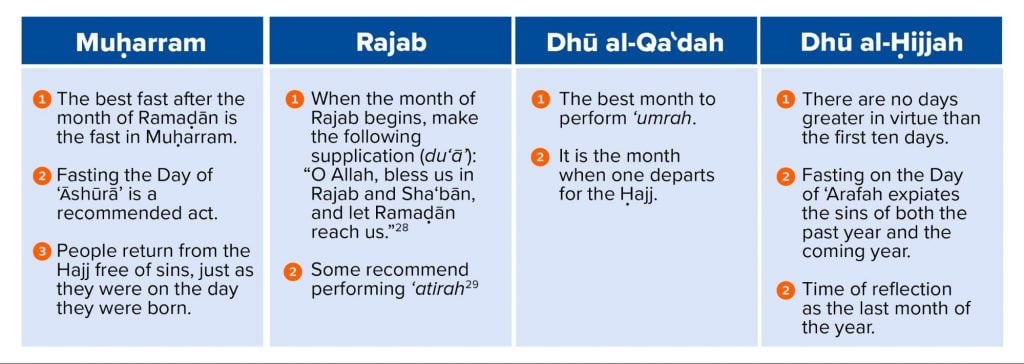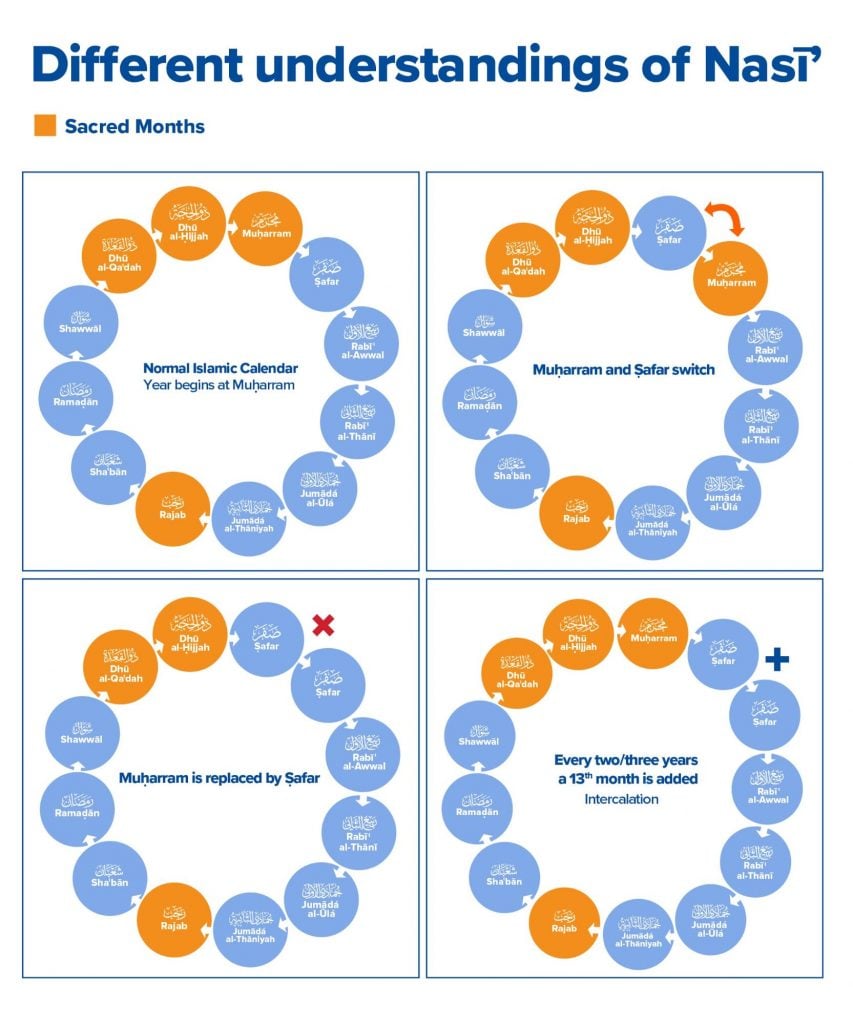[1] The generally approved standard or practice introduced by the Prophet ﷺ.
[4] Al-Qurṭubī,
al-Jāmiʿ li-aḥkām al-Qurʾān (Cairo: Dār al-Kutub al-Miṣrīyah, 1964), 10:455.
[5] F. C. De Blois, “Taʾrīkh”: I.1.iv. “Pre-Islamic and Agricultural Calendars of the Arabian Peninsula,” in
The Encyclopaedia of Islam, 2nd ed. (Leiden: Brill, 1955–2005), 10:260.
[6] The Islamic calendar was not the first lunar calendar. The Hebrew calendar, also called the Jewish calendar, was a lunisolar calendar that incorporated a thirteenth month into a nineteen-year cycle, at intervals oscillating between two and three years. See: Jere Bacharach,
A Middle East Studies Handbook (Seattle: University of Washington Press, 1984) 9; also see: Hideyuki Ioh, “The Calendar in Pre-Islamic Mecca,”
Arabica 61 (2014): 498–500.
[7] Qur’an
9:36. Allah refers to the lunar calendar as purpose (
ḥaqq) and the upright religion (
al-dīn al-qayyim), words typically used in reference to the Qur’an, God (Allah), and belief, pointing to the calendar’s significance. See: Qur’an 43:30, 10:32, and
12:40.
[8] There is no Year Zero.
[9] Lunar stations, also known as lunar mansions, are a segment of the ecliptic through which the moon passes in its orbit around the earth. The traditional Arab astrological system consisted of twenty-eight stations, and each station lasted approximately thirteen days. These stations were grouped together and associated with a specific constellation and zodiac sign. See: William Matthew O’Neil,
Time and the Calendars (Manchester: Manchester University Press, 1976), 53; also see: Amel Durakovic, “Celestial Lessons – Amel Durakovic – Session 1: Motion of the Heavenly Bodies,” Cambridge Muslim College, YouTube video, April 26, 2020,
https://www.youtube.com/watch?v=MZ-2zKMEFs8.
[10] Qur’an
10:5. Ibn Rajab (d. 795 AH) comments that the moon has been used to calculate the years, while the sun has been used to calculate the days and weeks, together completing the method of calculating time (
ḥisāb). Ibn Rajab,
Laṭāʾif al-maʿārif (Beirut and Damascus: Dār Ibn Kathīr, 1999), 38.
[11] Al-Qurṭubī,
al-Jāmiʿ li-aḥkām al-Qurʾān, 10:455.
[14] The scholars mention that the reason for the Prophet ﷺ saying “Rajab Muḍar, which stands between Jumādā [Thāniya] and Shaʿbān” was because Ramaḍān was known as Rajab Rabīʿa during the times of
jāhilīyah. In order to avoid confusion, he ﷺ mentioned Rajab Muḍar, which is between Jumādā (Thāniya) and Shaʿbān, as opposed to Ramaḍān (Rajab Rabīʿa), which is between Shaʿbān and Shawwāl. In summary, there were two Rajabs: Rajab Muḍar (the current Rajab) and Rajab Rabīʿa (Ramaḍān). See: Jawād ʿAlī,
al-Mufaṣṣal fī tārīkh al-ʿArab qabl al-Islām (Beirut: Dār al-Sāqī, 2001), 6:117.
[15] Bukhārī,
Ṣaḥīḥ al-Bukhārī,
kitāb tafsīr al-Qurʾān, 6:66, no. 4662.
[16] Al-Qurṭubī,
al-Jāmiʿ li-aḥkām al-Qurʾān, 10:89.
[17] Ibn Kathr,
Tafsīr al-Qurʼān al-ʿAẓīm (Beirut: Dār al-Ṭayyiba lil-Nashr wa-al-Tawzīʿ, 1999), 4:130.
[18] Al-Nīsābūrī,
Gharāʾib al-Qurʾān wa-raghāʾib al-Furqān (Beirut: Dār al-Kutub al-ʿIlmiyyah, 1996), 3:463
[19] Qur’an 9:36. Qatāda (d. 22 AH) interprets these months as being the sacred months, while Ibn ʿAbbās (d. 68 AH) understood the verse to be referring to all twelve months in general. Ibn al-Jawzī,
Zād al-Masīr (Beirut: Dār Ibn Ḥazm, 2002), 2:257.
[22] Al-Ṭabarī,
Tārīkh al-rusūl wa-al-mulūk (Cairo: Dār al-Maʿārif bi Miṣr, 1967), 4:574
. [23] Others argue that the Prophet ﷺ did not fight the people of Ṭāʾif in the month of Dhū al-Qaʿdah but just set up a post there during the month. Ibn Rajab,
Laṭāʾif al-Maʿārif (Beirut: Dār Ibn Kathīr, 1999), 224–25.
[25] Ibn Kathīr,
Tafsīr al-Qurʾān al-ʿAẓīm, 4:130.
[26] Al-Māwardī,
al-Nukat wa-al-ʿuyūn (Beirut: Dār al-Kutub al-ʿIlmiyya, 1999), 2:360.
[27] The most excellent fast after [fasting] in the month of Ramaḍān is the fast in the month of Muḥarram.
Muslim, Ṣaḥīḥ Muslim, kitāb al-ṣiyām, 2:321, no. 1163.
[28] Ibn Taymiyya,
Iqtiḍāʾ al-ṣirāṭ al-mustaqīm (Riyāḍ: Dār al-Ishbīlyā, 1998), 2:134. "اللهم بارك لنا في رجب وشعبان وبلغنا رمضان"
[29] ʿAtīra was an animal sacrifice in pre-Islamic Arabia, consisting of a sheep, a goat, or a camel. The
ʿatīra sacrifice was performed during the first ten days of Rajab. The Shāfiʿī school views this as recommended, while the majority say it has been abrogated. Jan Retsö, “ʿAtīra,” in
Encyclopaedia of Islam, 3rd ed. (Leiden: Brill, 2007).
[31] Abū al-Faraj ibn al-Jawzī,
al-Muntaẓim fī Tārīkh al-Mulūk wa al-Umam (n.p.: Dār al-Kutub al-ʿIlmiyyah, 1995),
4:226
[33] The eighth forefather of Prophet Muḥammad ﷺ.
[34] The year in which Abraha al-Ashram was defeated in Makkah, which is the same year in which Prophet Muḥammad ﷺ was born.
[35] The name of a war waged toward the end of the sixth century CE during the holy months that took place between the tribes of Quraysh and Banū Kināna on one side and the tribes of Qays-ʿAylān (without the Ghaṭafān) on the other.
[36] Ibn al-Jawzī,
al-Muntaẓim,
4:227.
[37] Al-Bīrūnī,
ʾĀthār al-Bāqiya [Vestiges of the past] (London: W.H. Allen, Pub. for the Oriental translation fund of Great Britain & Ireland, 1879), 35.
[38] Al-Ṭabarī,
Tārīkh al-rusul wa-al-mulūk, 2:390.
[39] It is also mentioned that ʿUbayd b. ʿUmayr said: “Muḥarram is the month of Allah. It is the first month of the year. It is the month when the Kaʿba is garbed, the month in which dates are recorded, and taxes are enforced. It is the month which has a day when mankind repents to Allah and Allah accepts their repentance.” Al-Ṭabarī, 389–90.
[40] Ross Marlay, “Qaddafi, Muammar,” in
The Encyclopedia of the Developing World (London: Routledge, 2006), 1338.
[41] Neil MacFarquhar,
The Media Relations Department of Hizbollah Wishes You a Happy Birthday: Unexpected Encounters in the Changing Middle East (New York: PublicAffairs, 2009), 38.
[42] Commonly mistaken as “After the
Hijrah.”
[43]John L. Esposito,
Islam: The Straight Path, rev. 3rd ed. (New York: Oxford University Press, 2005), 8.
[45] Al-Qurṭubī,
al-Jāmiʿ li-aḥkām al-Qurʾān, 8:137.
[46] Al-Ṭabarī,
Tārīkh al-rusūl wa-al-mulūk, 14:249.
[47] Hideyuki Ioh, “Calendar in Pre-Islamic Mecca,” 485.
[48] David Ewing Duncan,
Calendar: Humanity’s Epic Struggle to Determine a True and Accurate Year (New York: HarperCollins, 1999), 30.
[49] Ioh, “Calendar in Pre-Islamic Mecca,” 487.
[50] Al-Qurṭubī,
al-Jāmiʿ li-aḥkām al-Qurʾān, 8:137.
[51] This account also sheds light on why the month of Muḥarram, which is the first month on the Islamic calendar, is also the most tampered with. This is likely because Muḥarram provided a prime opportunity right after the Ḥajj pilgrimage to spread news of any changes to the calendar across the Arabian Peninsula as compared to other months.
[52] Uri Rubin, “The Great Pilgrimage of Muḥammad: Some Notes on Sūra IX,”
Journal of Semitic Studies 27, no. 2 (1982): 244.
[53] Ioh, “Calendar in Pre-Islamic Mecca,” 485
[54] Studies on circalunar rhythms of conception or birth rates extend to humans, where the lunar cycle has been suggested to also affect sleep and mental health. While these reports remain controversial, factors like the increase in “light pollution” from artificial light might contribute to any discrepancies between studies (see: Florian Raible, Hiroki Takekata, and Kristin Tessmar-Raible, “An Overview of Monthly Rhythms and Clocks,”
Frontiers in Neurology 8, May 2017,
https://doi.org/10.3389/fneur.2017.00189). We also find that the Prophet ﷺ recommended performing wet cupping therapy (
ḥijāma) on either the seventeenth, nineteenth, or twenty-first of every lunar month.
Sunan Abū Dāwūd, no. 3861.
[55] Al-Qurṭubī,
al-Jāmiʿ li-aḥkām al-Qurʾān, 10:198.
[56] Edward William Lane states: “The two months to which it is applied being [said to be] so called because, when the months were named, these two fell in the season of the freezing of water: (ISd, L, Mṣb:) [but this derivation seems to have been invented when the two months thus named had fallen back, into, or beyond, the winter; for when they received this appellation, the former of them evidently commenced in March, and the latter ended in May; therefore I hold the opinion of M. Caussin de Perceval, that they were thus called because falling in a period when the earth had become dry and hard by reason of paucity of rain, from
jamādun, an epithet applied to land upon which rain has not fallen, or from
jumādā, an epithet applied to an eye that sheds few tears.” See: Edward William Lane and Stanley Lane-Poole, “
Jumādā,” in
Arabic-English Lexicon (New York: F. Ungar Pub. Co, 1955); also see: Ibn Kathīr,
Tafsīr al-Qurʾān al-ʿAẓīm, 4:146–47.
[57] Ioh, “Calendar in Pre-Islamic Mecca,” 477.
[59] Abū Dāwūd al-Sijistānī,
Sunan Abū Dāwūd (Cairo: al-Risālah al-ʿĀlimiyyah, 2009), 6:5144, no. 4031.
[60] Najm al-Dīn al-Ghazzī,
Ḥusn al-tannabbuh li-mā warada fī al-tashabbuh (Beirut: Dār al-Nawādir, 2011), 7:298.
[61] I am assuming that the Gregorian calendar is associated with Christianity based on their epoch, which refers to the birth of Jesus. I am aware that the CE abbreviations have been used referring to the Common Era as a way to secularize the calendar; however, for the purpose of this argument, I made the assumption that the Gregorian calendar is the calendar of the Christians.
[62] Also known as Ḥarb b. Ismāʿīl al-Kirmānī. He was a student of Aḥmad ibn Ḥanbal.
[63] Ibn Taymiyya,
Iqtiḍāʾ al-ṣirāṭ al-mustaqīm, 1:518.
[64] The Tanzimat reforms promulgated in the Ottoman Empire between 1839 and 1876 under the reigns of the sultans Abdulmecid I and Abdulaziz. These reforms, heavily influenced by European ideas, were intended to effectuate a fundamental change of the empire from the old system based on theocratic principles to that of a modern state.
[65] Safiye Kıranlar, “Even the Calendar Changes in Modern Times: The Story of the Calendar from the Ottomans to the Republic 1840–1945,”
International Journal of Turcologia 6 (2008): 39–60.
[66] Ibn Khaldūn and Franz Rosenthal,
The Muqaddimah: An Introduction to History (Princeton, NJ: Princeton University Press, 1967), 196.



